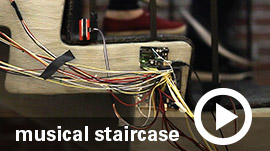Collaboration, innovation and creative design are a few ways OhioLINK and member libraries inspire students, staff, faculty and researchers to develop new art, music and mechanical contraptions. Recently, an installation of musical stairs, an impressive example of collaboration, was on display at Otterbein University’s Courtright Memorial Library.
From March 7-11, the library featured a musical staircase built by students in the university’s engineering, music and art departments. Throughout the time the staircase was active, students, faculty and staff were surprised and excited about the new audio-visual display. Some onlookers teetered back and forth in disbelief, while one man even spilled his coffee in shock. Others ran up and down the stairs multiple times to hear the music repeated.

The idea for the project was born in an electroacoustic music class, taught by Professor Jennifer Merkowitz, Ph.D., focusing on the integration of technology with music to create sound. Merkowitz is a composer and consumer of new music and often turns to OhioLINK’s music library to obtain recordings and music scores that she would not be able to access through Otterbein’s resources alone.
“OhioLINK is usually a really good source of finding musical scores that we might not have in our campus building,” Merkowitz said. “I will go looking for kind of the obscure thing that’s not really in circulation everywhere.”
One could say it was Merkowitz’s love for the obscure that kicked off the project. Merkowitz introduced her students to a new technology, the Makey Makey, an invention kit made of a 2-inch control board that plugs into a computer. Using alligator clips, the Makey Makey allows users to create a computer key input out of anything that can conduct electricity – including stairs. After the class saw a video of a musical staircase, the students set out to create one of their own, which led to a realization that they needed some assistance with the technical logistics.
“We started with a really basic foil implementation on our own and thought about trying to use some sensors and how we might be able to make something that was a little more sophisticated,” Merkowitz said.
Merkowitz saw a great opportunity for student collaboration and contacted the engineering department at Otterbein. When a class of sophomore engineering students learned about the idea for a musical staircase, several students, including Erick Martinez, a mechanical engineering major, jumped at the opportunity.
“I was like ‘who doesn’t want to make a staircase sing?’” Martinez said.
The engineering students worked with the music students to set up ultrasonic rangefinder sensors that detected whether someone was on the stair. The sensors connected to an Arduino board, which is connected to a laptop. The music students used a program called Max/MSP to select a particular sound to be played. To allow the program to talk to the Arduino, students in both disciplines had to cross-train each other on semantics and logistics.
“It’s neat to work with someone that’s really good with technology instead of someone who is just good at making music with technology,” said Owen Hopper, a sophomore studying music.
Once the music was set up, the group decided to add one more element: art. Art students under the direction of Professor Amanda Kline added a slideshow of photography that went along with each musical tone. Though an unlikely grouping, the students from different disciplines were aware that this collaborative project was a test-drive for what life after graduation could entail.
“Artists do not work in a vacuum,” Kline said. “Successful contemporary artists collaborate with people from across many different fields, so it’s really exciting for them to be able to do that.”
This collaboration was a great learning experience for all the students and professors involved and is something they hope to continue into the future. The library not only provided the space for the musical stairs, but also provided the resources needed to research and implement their design.
To learn more about the musical stairs project, watch our newest video profile: http://vimeo.com/168817902


